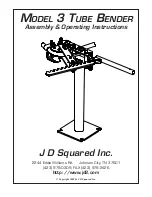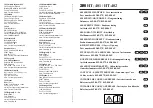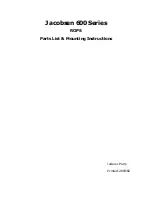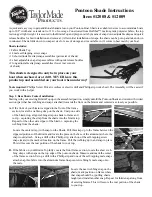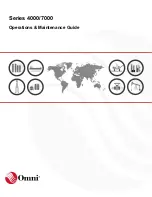
27. Before getting off the seat:
B. Set the parking brake and disengage the PTO.
A. Move traction pedal to neutral position and re-
C. Shut the engine off and remove key from ignition
move foot from pedal.
switch. Wait for all movement to stop before getting
off the seat.
While Doing Maintenance, Troubleshooting, Testing, Adjustments or Repairs
28. Remove key from ignition switch to prevent acciden-
tal starting of the engine when servicing, adjusting, or
storing the machine.
29. Make sure you understand a service procedure
before working on the machine. Unauthorized modifica-
tions to the machine may impair the function, safety and
life of the machine. If major repairs are ever needed or
assistance is desired, contact an Authorized TORO
Distributor.
30. To reduce potential fire hazard, keep the engine free
of excessive grease, grass, leaves, and accumulations
of dirt. Clean protective screen on front of engine fre-
quently. When cleaning parts, do not use flammable
solvents, such as diesel fuel, kerosene or gasoline.
31.
THE ASBESTOS BRAKE LININGS CONTAIN ASBES-
TOS FIBERS. BREATHING ASBESTOS DUST MAY BE HAZ-
ARDOUS TO YOUR HEALTH AND MAY CAUSE SERIOUS
RESPIRATORY OR OTHER BODILY HARM
. For your pro-
tection:
A.
AVOID CREATING DUST
.
B. Do not remove brake drum without proper
equipment.
C. Do not work on brake linings without proper
protective equipment.
D. Do not replace brake linings without proper pro-
tective equipment.
E. Do not attempt to sand, grind, chisel, file, hammer,
or alter brake linings in any manner without proper
protective equipment.
F. Follow O.S.H.A standards for proper protective
devices to be used when working with asbestos
materials.
32. If the cutting unit discharge area ever plugs, disen-
gage PTO and shut engine off before removing the
obstruction.
33. Make sure machine is in safe operating condition by
keeping nuts, bolts, and screws tight. Check all cutting
unit blade mounting bolts frequently to assure they are
torqued to proper specifications (See Cutting Unit Op-
erator’s Manual).
34. If machine is equipped with roll-over protection
(ROPS), periodically inspect the roll bar and roll bar
mounting. Repair as necessary. Do not weld, cut, drill,
or modify roll bar in any manner.
35. Make sure all hydraulic line connectors are tight, and
all hydraulic hoses and lines are in good condition
before applying pressure to the system.
36. Keep body and hands away from pin hole leaks or
nozzles that eject hydraulic fluid under high pressure.
Use paper or cardboard, not hands, to search for leaks.
Hydraulic fluid escaping under pressure can have suffi-
cient force to penetrate skin and do serious damage. If
fluid is ejected into the skin, it must be surgically re-
moved within a few hours by a doctor familiar with this
form of injury or gangrene may result.
37. Before disconnecting or performing any work on the
hydraulic system, all pressure in system must be re-
lieved by stopping engine and lowering implement to the
ground.
38. If the engine must be running to perform mainte-
nance or an adjustment, keep clear of PTO shaft, cutting
unit blades, and other moving parts.
39. Do not over-speed the engine by changing the
governor settings. To ensure safety and accuracy, have
an Authorized TORO Distributor check maximum en-
gine speed with a tachometer.
40. Engine must be shut off before checking oil or
adding oil to the crankcase.
41. Disconnect the cables from the battery before serv-
icing the machine. If battery voltage is required for
troubleshooting or test procedures, temporarily connect
the battery.
42. Do not charge a frozen battery because it can
explode and cause injury. Let the battery warm to 60
°
F
(15.5
°
C) before connecting to a charger. Charge the
battery in a well-ventilated place so that gases produced
while charging can dissipate. Since the gasses are
explosive, keep open flame and electrical spark away
from the battery; do not smoke. Nausea may result if the
gases are inhaled. Unplug the charger from the electri-
cal outlet before connecting or disconnecting the
charger leads from the battery posts.
Groundsmaster
®
300 Series
Page 1 - 3
Safety Instructions
Summary of Contents for Groundsmaster 328-D
Page 2: ......
Page 12: ...Torque Specifications Page 2 4 Rev A Groundsmaster 300 Series ...
Page 44: ...Troubleshooting Page 4 16 Groundsmaster 300 Series ...
Page 45: ...Groundsmaster 300 Series Page 4 17 Troubleshooting ...
Page 171: ...Groundsmaster 300 Series Page 6 25 Testing ...
Page 220: ...Repairs Page 7 24 Groundsmaster 300 Series ...
Page 320: ...Troubleshooting Troubleshooting Page 11 4 Groundsmaster 300 Series ...
Page 348: ...Troubleshooting Troubleshooting Page 12 4 Groundsmaster 300 Series ...
Page 379: ...Troubleshooting Groundsmaster 300 Series Page 13 3 Troubleshooting ...
Page 400: ...This page is blank ...
Page 401: ...This page is blank ...

























